It can be tough to pick the perfect bag for your summer outdoor activities, right? A good bag makes all the difference, preventing hassle and making your adventures much more enjoyable.
The right summer gear bag depends on your activity: running needs lightweight hydration vests, hiking benefits from versatile daypacks, and cycling works best with aerodynamic frame bags or compact backpacks, all focusing on comfort and accessibility.

Choosing the right bag isn’t just about carrying your stuff; it’s about enhancing your experience. I’ve learned that a poorly chosen bag can quickly turn a fun outing into a frustrating ordeal, so let’s explore what makes a bag truly suitable for your summer escapades.
What Types of Bags Work Best for Running, Hiking, or Cycling?
Picking the right bag for your specific sport can be confusing, can’t it? The type of activity you’re doing really dictates what kind of bag you should use.
The best bags for outdoor activities vary significantly by sport: runners need lightweight hydration packs or belts to minimize bounce, hikers benefit from ergonomic daypacks with ample storage, and cyclists require compact, aerodynamic bags that don’t hinder movement or fit securely on their bike.

When I first started Avecobaggie, I noticed how many small business owners struggled with this exact problem. They were using generic bags for very specific needs. For example, a heavy hiking pack isn’t going to cut it for a quick run, and a small running vest won’t hold enough for a long day hike. It became clear to me that one size definitely does not fit all in the world of outdoor gear bags. We need to look closely at what each activity demands from our bag.
Running Bag Essentials: What to Look For?
Running bags need to be incredibly lightweight and stable. You don’t want anything bouncing around and throwing off your stride. This means looking for features that keep the bag snug against your body. For short runs, a waist pack or armband works great for essentials like your phone, keys, and a gel. I use a simple waist pack1 for my evening runs around the neighborhood, and it’s perfect because it barely feels like it’s there. For longer runs, or when it’s hot, hydration vests are a game-changer. These vests often come with a built-in reservoir or pockets for soft flasks, letting you carry water without feeling bulky. My general rule is to look for minimal bulk and maximum stability.
| Feature | Benefit | Ideal For |
|---|---|---|
| Lightweight | Reduces effort, improves speed | All running, especially long distances |
| Snug Fit | Prevents bounce, reduces chafing | Trail running, speed work |
| Hydration Ready | Easy access to water, prevents dehydration | Long runs, hot weather |
| Small Pockets | Securely holds essentials (keys, phone) | Short runs, quick access |
Hiking Bag Choices: What’s the Difference?
Hiking bags need to balance capacity with comfort. The duration and difficulty of your hike will determine the size and features you need. For short day hikes, a lightweight daypack (around 15-25 liters) is usually enough for water, snacks, a light jacket, and a first-aid kit. I remember one time, I tried to use my regular work backpack for a day hike, and it was a disaster—no proper ventilation, and the straps dug into my shoulders. That’s when I really appreciated the design of a dedicated hiking pack. For longer or multi-day hikes, you’ll need a medium to heavy-duty backpack (30-60+ liters) with better support, a good hip belt, and external attachment points for gear. The key here is proper weight distribution and ventilation.
| Type of Hike | Bag Capacity (Liters) | Key Features |
|---|---|---|
| Short Day Hike | 15-25 | Lightweight, hydration sleeve |
| Long Day Hike | 25-40 | Padded straps, ventilation, hip belt |
| Multi-Day Trek | 40-70+ | Adjustable torso, heavy-duty frame |
| Technical Climbing | 30-50 | Tool loops, durable fabric, slim profile |
Cycling Bag Options: What Are My Options?
Cycling bags need to be aerodynamic and secure so they don’t interfere with your ride. For road cycling, frame bags and saddle bags are popular because they keep the weight low and don’t create much drag. You can carry essentials like a tools, and a small snack. For longer rides or commutes, a cycling-specific backpack is a good choice. These often have a slim profile, good ventilation, and secure straps that prevent bouncing. I’ve tried riding with a regular backpack, and the sweat build-up on my back was intense, plus it shifted around a lot. That’s why a good cycling backpack with a ventilated back panel is so important. Drawstring bags are also an option for very light loads and short, casual rides, but they offer less stability.
| Type of Cycling | Bag Type | Key Features |
|---|---|---|
| Road Cycling | Frame Bag, Saddle Bag | Aerodynamic, secure attachment |
| Commuting | Cycling Backpack | Ventilated back, reflective details |
| Mountain Biking | Hydration Pack | Stable, high capacity for water |
| Casual Rides | Drawstring Bag | Lightweight, simple |
What Essentials Should Go Inside Your Summer Backpack?
Deciding what to pack can be overwhelming, can’t it? Knowing what truly belongs in your summer backpack makes a big difference.
For summer outdoor activities, your backpack essentials should always include ample hydration, high-energy snacks, first-aid supplies, and sun protection, with insect repellent and navigation tools being highly recommended for safety and comfort.

I’ve learned through many trials that a well-packed bag is just as important as the bag itself. There have been times I’ve forgotten something seemingly small, like bug spray, and it completely changed my experience. My team and I at Avecobaggie always emphasize thinking about the "what ifs" when packing. It’s not just about what you think you’ll need, but what you might need.
Must-Have Outdoor Gear: What’s Truly Essential?
When I’m heading out for any summer adventure, certain items are non-negotiable. First and foremost, hydration is key. I always carry more water than I think I’ll need, either in a large water bottle or a hydration bladder. For hotter days, electrolyte mixes are also a must. Energy boosters like granola bars, dried fruit, or gels keep my energy up, preventing me from hitting a wall. A basic first-aid kit is also always in my bag. Even a small cut or blister can become a big problem if not addressed quickly. Sun protection—sunscreen, a wide-brimmed hat, and sunglasses—is another must-have for summer. I’ve seen firsthand how a bad sunburn can ruin an otherwise perfect day.
| Category | Essential Items | Why It’s Needed |
|---|---|---|
| Hydration | Water bottles, hydration bladder, electrolyte mix | Prevents dehydration, maintains energy |
| Nutrition | Energy bars, gels, dried fruit, nuts | Sustains energy, prevents low blood sugar |
| Safety | First-aid kit, whistle, emergency blanket | Addresses minor injuries, signals for help |
| Sun Protection | Sunscreen, hat, sunglasses | Protects from UV damage, prevents heatstroke |
Highly Recommended but Not Always Essential: What Else Helps?
Beyond the absolute essentials, there are other items that can greatly improve your outdoor experience. Insect repellent is high on my list, especially when I’m in wooded areas or out during dawn or dusk. Nobody wants to spend their hike swatting mosquitoes. Wet wipes also are super handy for quick clean-ups, whether it’s muddy hands or sticky snack residue. A multi-tool or a small knife can be incredibly useful for unexpected repairs or opening stubborn packaging. These items might not be critical for survival, but they certainly add to comfort and convenience, which, in my book, makes for a much better adventure.
| Category | Recommended Items | How It Helps |
|---|---|---|
| Comfort | Insect repellent, wet wipes, small towel | Repels bugs, quick clean-ups, dries off sweat |
| Utility | Multi-tool, headlamp (with extra batteries) | Minor repairs, illumination, safety in low light |
| Navigation | Map, compass, GPS device (phone apps) | Prevents getting lost, especially in new areas |
| Communication | Fully charged phone, portable power bank | Emergency contact, essential for smart tools |
Why Hydration, Snacks & Bug Protection Are Non-Negotiable?
Ever felt completely drained or covered in bites after an outdoor activity? It’s miserable, right? These three things are often overlooked but are absolutely critical.
Hydration, snacks, and bug protection are non-negotiable because they directly impact your safety, energy levels, and overall comfort during summer outdoor activities, preventing dehydration, low blood sugar, and irritating insect-borne issues.

I’ve had my share of uncomfortable moments outdoors because I didn’t take these seriously enough. One hot summer hike, I underestimated how much water I needed and ended up feeling lightheaded. Another time, I forgot bug spray and spent the whole evening scratching. These experiences taught me that being prepared isn’t just about big gear; it’s about the small, essential details that keep you healthy and happy.
The Importance of Hydration: Why Drink Up?
In summer, especially when you’re active, your body loses a lot of water through sweat. If you don’t replace that fluid, you risk dehydration, which can quickly lead to fatigue, dizziness, and even more serious health issues. This is why I always preach constant hydration. It’s not just about drinking water when you feel thirsty; it’s about proactively sipping water or electrolyte drinks2 throughout your activity. For instance, when I’m out on a long bike ride, I make sure to drink small amounts every 15-20 minutes, even if I don’t feel parched. Electrolyte drinks are especially important because they replace the salts and minerals your body loses, helping maintain proper fluid balance and preventing muscle cramps.
| Risk of Dehydration | Symptoms | Prevention Strategy |
|---|---|---|
| Fatigue, Dizziness | Dry mouth, headache, muscle cramps | Sip water frequently, don’t wait for thirst |
| Heat Exhaustion | Nausea, weakness, heavy sweating | Use electrolyte drinks, wear breathable clothing |
| Heatstroke | Confusion, rapid pulse, high body temp | Rest in shade, seek medical attention immediately |
Fueling Your Adventures: Why Snacks Matter?
Think of snacks as your body’s fuel. When you’re hiking, running, or cycling, your body burns through energy stores. If you don’t replenish them, you can experience low blood sugar, which can make you feel weak, shaky, and unable to concentrate. This is especially true for longer activities. I always pack easy-to-eat, high-energy snacks3 like nuts, fruit leathers, or energy gels. These provide quick bursts of energy when you need them most. I often schedule snack breaks during my hikes, even if I don’t feel hungry, just to keep my energy levels consistent. It’s like topping off your car’s gas tank before it’s completely empty.
| Type of Snack | Benefit | Example |
|---|---|---|
| Quick Energy | Fast absorption for immediate boost | Energy gels, dried fruit, candy |
| Sustained Energy | Slow release, keeps you going longer | Nuts, trail mix, whole-grain bars |
| Electrolyte Rich | Replaces lost salts | Pretzels, electrolyte chews |
Staying Protected: Why Bug Spray is Essential?
Nothing ruins an outdoor experience faster than constant mosquito bites or ticks. Beyond the annoyance, many insects can carry diseases. That’s why bug protection is a non-negotiable for me, especially during summer and when I’m in wooded or marshy areas. Even in urban parks in the evening, I’ve found myself swatting away mosquitoes. I prefer a good insect repellent spray for exposed skin and sometimes even wear long, light clothing to minimize skin exposure. I’ve learned that a few extra seconds spent applying bug spray before I head out saves me hours of itching and discomfort later.
| Insect Risk | Protection Method | Best Use Case |
|---|---|---|
| Mosquito Bites | Repellent (DEET, Picaridin), long sleeves | Wooded areas, dusk/dawn |
| Tick Bites | Permethrin-treated clothing, skin checks | Tall grass, brushy areas, after hike |
| Annoyance/Irritation | Repellent, bug nets (for head) | Anywhere insects are prevalent |
What Smart Tools and Tech Gear Make Outdoor Trips Safer?
Wondering if you need more than just the basics to stay safe outside? Modern tools and tech can seriously upgrade your outdoor safety.
Smart tools and tech gear like mini outdoor lighting, multi-functional knives, and portable power banks significantly enhance safety and preparedness for outdoor trips, especially during unexpected weather changes, night travel, or emergency situations.

I’ve seen how quickly an outdoor situation can change, especially with weather or daylight. Relying solely on basic gear can leave you vulnerable. That’s why I always recommend incorporating a few smart tools and tech gadgets. They’re not just about convenience; they’re about peace of mind and, sometimes, crucial safety.
Lighting the Way: Why a Headlamp is Essential?
Even if you plan to be back before dark, things can change quickly. A wrong turn, a slower pace, or unexpected weather can extend your trip into the evening. That’s why a mini outdoor lighting device, like a headlamp, is absolutely essential. It keeps your hands free, which is incredibly helpful if you’re navigating tricky terrain or setting up camp in the dark. I always pack a small, lightweight headlamp with extra batteries, even for daytime hikes. It’s a small item that can make a huge difference in an emergency or when you just need to pack up after the sun sets. I’ve heard too many stories of people getting caught in the dark unprepared.
| Type of Lighting | Pros | Cons | Ideal Scenario |
|---|---|---|---|
| Headlamp | Hands-free, directional light | Can be bulky, battery dependent | Hiking, camping, trail running |
| Mini Flashlight | Compact, durable, focused beam | Requires holding, limited spread | Backpacking, emergency kits |
| Lantern (compact) | Wide area illumination, ambient light | Heavier, less portable, no focused beam | Camp, tent, stationary use |
The Power of a Multi-Tool: Why Carry One?
A multi-tool is like carrying a toolbox in your pocket. Whether it’s for minor gear repairs, opening stubborn packaging, or even just cutting a piece of tape, a good multi-tool can solve many small problems that arise outdoors. I’ve used mine for everything from tightening a loose screw on my bike to opening a can of food on a camping trip. They come in various sizes and with different functions, so you can pick one that fits your needs. For outdoor adventures, I look for models with a good knife blade, pliers, and perhaps a small saw. It’s truly amazing how many situations a single, well-chosen tool can get you out of.
| Tool Feature | Common Use Cases | Benefit |
|---|---|---|
| Knife Blade | Cutting rope, opening packages, general tasks | Versatility, everyday utility |
| Pliers | Gripping, bending wire, small repairs | Mechanical fixes, holding items |
| Saw | Cutting small branches, processing wood | Fire starting, shelter building |
| Screwdrivers | Tightening/loosening screws | Gear repair, equipment adjustment |
Staying Connected: Why a Power Bank is Crucial?
In today’s world, our phones are often our cameras, navigation devices, and emergency communication tools. Running out of battery power can be more than just inconvenient; it can be a safety hazard. That’s why a portable power bank is absolutely vital. I always make sure mine is fully charged before any trip, even if it’s just for a day. It’s essential for recharging my phone, GPS device, or even my headlamp. When you’re relying on technology for safety and navigation, a reliable power source is non-negotiable. I remember a time my phone died while I was trying to use a map app, and it was a stressful situation until I remembered my power bank.
| Feature | Benefit | Considerations |
|---|---|---|
| Capacity (mAh) | Determines number of recharges | Higher mAh = more power, heavier |
| Portability | Easy to carry, fits in small spaces | Size and weight vary by capacity |
| Charging Speed | Quick power delivery to devices | Look for fast-charging capabilities |
| Durability | Withstands outdoor conditions | Water/dust resistant models available |
Conclusion
Choosing the right summer gear bag means considering your activity’s specific demands. Prioritize lightweight designs, proper hydration, and safety essentials to make your outdoor adventures comfortable and worry-free.
-
Explore this link to discover how a waist pack can enhance your running experience by providing convenience and comfort. ↩
-
Explore how electrolyte drinks can enhance your hydration strategy, especially during physical activities. ↩
-
Discovering the best high-energy snacks can enhance your performance and keep you energized during your adventures. ↩


